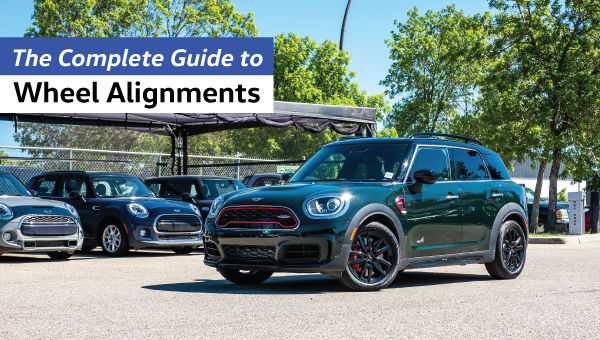The Complete Guide to Wheel Alignment and Why It's Important
May 05 2022,

The Complete Guide to Wheel Alignment & Why It's Important!
Vehicle wheel alignment isn’t something that is often thought about. We can see blown headlights, bald tires, and the damage caused by not changing the oil in your MINI.
What is alignment anyway? Alignment is stability. It’s the process of adjusting the angles of a vehicle's suspension.
Of course, it isn’t that simple, nor is it something we should dismiss! A misaligned vehicle can lead to significant tire wear, loose steering, and suspension issues. Waiting too long to correct a misalignment will also affect your fuel economy and the vehicle's lifespan. In today’s economy both can be costly.
A vehicle needs to be periodically aligned because parts wear out over time. As much as we don’t want to admit it, our driving habits can have an affect too; a pothole or curb, excessive braking, turning too sharply, or driving on rough roads with big dips. Having your alignment checked once or twice a year will extend the life of your vehicle.
Ways to measure Wheel Alignment:
Wheel alignment is a critical part of vehicle maintenance. It ensures that the wheels point in the right direction so all four tires wear evenly.
The three main alignment measurements are camber, caster, and toe.
Camber refers to the angle of a tire in relation to the ground when viewed from front to back. Parallel tires lead to less wear.
Caster refers to the angle of a tire when viewed from side to side. Newer vehicles will usually have positive caster to improve stability.
Toe refers to the degree that one or more tires point inward or outward from straight ahead. Tire wear is a primary result of toe misalignment.

Signs you need Wheel Alignment:
Tugging from the steering wheel
One of the most common indicators a driver observes is when their vehicle pulls to the left or right. Minor drifting or tugging to the side is common as roads are not always flat but the driver should be able to drive straight without much steering assistance.
Crooked steering wheel
If you have concerns about a crooked steering wheel, it is an indication of vehicle misalignment. When driving down a straight road, keep your steering wheel in the middle so the logo sits straight.
Shaking
If you notice your car shaking or the steering wheel wobbling, there could be a number of possible reasons. It could be a sign of a problem with the wheel alignment. Car vibrations could be caused by worn out parts or tire imbalances. Wheel alignment is not the same as car alignment and should be checked on a regular basis. Wheel alignment frequently includes wheel balancing, which equalises the weight in the wheels as they rotate.
Your tires are worn
The wear on your tires typically indicates the overall health of your car. A professional and experienced mechanic will examine the odd wear on your tires to gain a thorough understanding of how the weight of the wheel is distributed throughout the vehicle. A minor tilt at the top of the tire, as well as significant wear focused on the inner or outside, signal that the vehicle needs to be realigned.
Ignoring wheel alignment concerns can lead to worse problems and unnecessary costs. When camber and toe alignment parameters deviate from the manufacturer's specifications, it may result in:
- Worn-out tires, steering, and suspension components - this is expensive
- Excessive tension on the entire suspension system - this is harmful.
- Poor handling and road holding - this is highly dangerous
While generally recommended that a vehicle alignment be performed every 9,000 Kilometres, you should also have it checked if you have sudden events such as a serious road danger like hard braking for a wildlife or spinning out from black ice.


